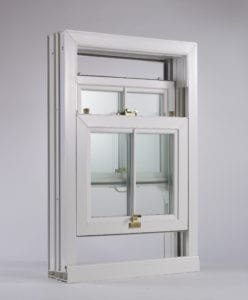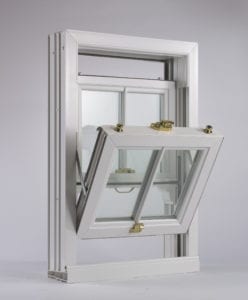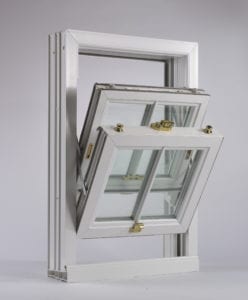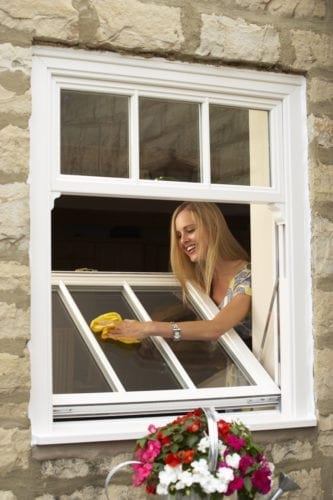How To Clean uPVC Sliding Sash Windows
Share this story!
Share this post to any popular social media, email it to a friend or print it off.
All uPVC sliding sash windows from Quickslide come with an easy clean tilt facility as standard*. When cleaning your windows at home you are likely to be facing a burdensome task, especially when you need to clean the windows on the upper floors. Therefore, many people usually have their windows cleaned by a professional window cleaner costing around twenty pounds each time. With our sliding sash windows, you could save this money as you would be able to clean every window from inside your home yourself. Each sash has both a tilt and slide facility allowing you to reach all sections of the window.
Safety Precautions
You need to ensure that when cleaning windows, you put your safety first. Not just because windows tend to be placed at height but also because they are heavy structures, particularly sash windows. Make sure you don’t try to clean windows, which are too high to reach without having your feet on the ground; many people will be tempted to stand on a stool or chair to reach their windows, but this should be avoided.
Here are a few simple steps to follow:
1. Position the Window
Slide the bottom sash up and tilt it by pulling the knobs into the sash. Place the bottom sash in its tilted position by carefully pulling the sash towards you. Then slide the top sash down and tilt it by pulling the knobs into the sash. You should now be able to pull the top sash towards you into its tilted position.



2. Use Cloth and Soapy Water
Using a cloth and soapy water, wipe down the frame and glass from top to bottom. You may want to consider changing the soapy water in between cleaning the frame and glass to get the best result. For the internal glass pane, a glass cleaner should do the job perfectly, as the internal face doesn’t tend to be as dirty as the external face. Finish off by wiping down the window with clear, clean water to remove any leftover soap.
3. Close the Window
Close the window by pushing the top sash into its upright position and slide it to the top. Then, push the bottom sash into its upright position, slide it down and lock both sashes into an interlocked position. Before proceeding with the next window, check that both the external and internal sides are clean and clear of any marks.
4. Inspect the Window
Whilst cleaning your windows, it’s a good idea to be aware and observant of the overall quality of the window. Wear and tear is inevitable, but if you spot any signs of damage, it is best to act quickly to avoid further damage.
Alternative Products
Nowadays, so many uPVC windows, especially sash windows, come with a timber look woodgrain foil, and it’s therefore important to only use a gentle, non-flammable foil-safe cleaner. You can buy a solvent cleaner dedicated to woodgrain foiled windows and doors that cleans the products without damaging them. Most window suppliers, such as Quickslide, will have a range of cleaning products available to buy, so if in doubt, it’s always better to ask. The same process advice applies when cleaning uPVC and aluminium doors.
Things to Avoid
When cleaning your sash or casement windows, you should not use any harsh products such as bleach or nail varnish to get any marks off, as it could scratch or warp the frames. Quickslide recommends using a clean cloth together with a non-coarse neutral solution, such as washing up liquid mixed with hot water. This will get the marks off and prevent your windows from any damage.
For any more information on how to clean sash windows talk to our Customer Service team on 03332 412 240.
*Please note that slide and tilt restrictions apply on certain sliding sash windows.

You May Also Be Interested In:
- Ways To Maintain Sliding Sash Windows
- 7-Step Guide: How to Adjust Your uPVC Windows
- Comparing uPVC Sash Windows vs Wooden Double Glazed Sash Windows
- Ultimate Guide to Sliding Sash Windows
- Will Quickslide Sliding Sash Windows Withstand Draughts and Leaks?
- Bifold Door Maintenance Made Easy – Follow These Simple Steps - 18 November 2024
- Bifold Doors vs. Slide and Stack Doors: Which Is Right for You? - 8 July 2024
- Quickslide Customer Days Heralded a Resounding Success - 21 June 2024
Please note, our news articles are relevant and accurate at the time of release, but as technical developments dictate, and times goes by the information in this article may no longer be applicable. If you have questions, please contact us using our online contact form or call us on 03332 412 240.






